about this book
Dear Readers,
Thank you for your interest in our book. Since we released the book two years back, 160,000+ readers aross the globe have downloaded our open-access book. It is wonderful to know that we are a part of a larger community of scholars and practitioners who are working towards enhacing food systems in countries across the world.
Our continued scholarship and engagement (on the ground, in the field, in policy circles, in board rooms and in homes) will be key to realizing a FoodSystems transition towards a nutrition secure future. I would love to hear your experiences, thoughts or research on this topic(s). You can reach me at aaiyar[at]unr[dot]edu & aiyar[dot]anaka[at]gmail[dot]com.
Warm regards
Anaka
chapters
Chapter 1. Indian Food Systems towards 2050: Challenges and Opportunities
Chapter 2. Economic Growth, Agriculture and Food Systems: Explaining Regional Diversity
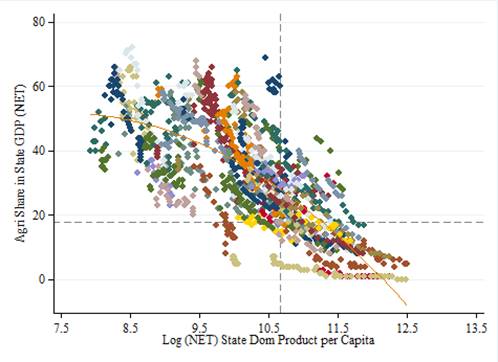 In this chapter, we identify two major reasons for the growing sub national divergence. India has doubled its GDP per capita over the last decade. However, India’s growth experience has been marred by a subnational divergence. Development in States like Goa compare to countries in Latin America, while states like Uttar Pradesh are comparable to low income countries in Sub Saharan Africa. Why? First, comparative advantages in resource availability has led to some states developing faster. Second, a robust non-agricultural sector has been essential for absorbing excess labor from the agricultural sector. However, migration towards opportunities in the non agricultural sector has been slower than expected due to labor market frictions. Using our food systems approach, we are able to identify that states that have continued to remain focused on staple grain production or in developing their economic sectors, where they have no comparative advantages, have been locked into low growth equilibrium. Given the projections of urbanization, reducing search and entry costs into the urban labor market as well as up skilling the rural and urban workforce is the need of the hour.
In this chapter, we identify two major reasons for the growing sub national divergence. India has doubled its GDP per capita over the last decade. However, India’s growth experience has been marred by a subnational divergence. Development in States like Goa compare to countries in Latin America, while states like Uttar Pradesh are comparable to low income countries in Sub Saharan Africa. Why? First, comparative advantages in resource availability has led to some states developing faster. Second, a robust non-agricultural sector has been essential for absorbing excess labor from the agricultural sector. However, migration towards opportunities in the non agricultural sector has been slower than expected due to labor market frictions. Using our food systems approach, we are able to identify that states that have continued to remain focused on staple grain production or in developing their economic sectors, where they have no comparative advantages, have been locked into low growth equilibrium. Given the projections of urbanization, reducing search and entry costs into the urban labor market as well as up skilling the rural and urban workforce is the need of the hour.Chapter 3. Rural Livelihood Challenges: Moving out of Agriculture
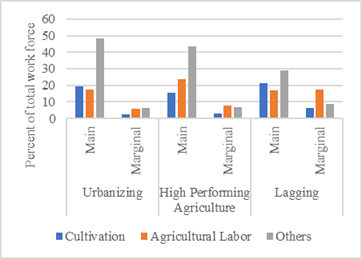 In this chapter, we deliberate upon the role of non-farm sector in the food systems. Livelihood diversification out of agriculture leads to overall economy wide productivity facilitating a swifter pace of structural transformation and sustainable rural poverty reduction. We highlight the role of non-farm sector for job creation in rural areas, especially along the rural-urban continuum for structural transformation to take place. We focus on the blurring of the rural-urban distinction as a means to diversify the portfolio of economic opportunities available to the rural households, thereby enabling greater rural income and improved access to food and nutrition.
In this chapter, we deliberate upon the role of non-farm sector in the food systems. Livelihood diversification out of agriculture leads to overall economy wide productivity facilitating a swifter pace of structural transformation and sustainable rural poverty reduction. We highlight the role of non-farm sector for job creation in rural areas, especially along the rural-urban continuum for structural transformation to take place. We focus on the blurring of the rural-urban distinction as a means to diversify the portfolio of economic opportunities available to the rural households, thereby enabling greater rural income and improved access to food and nutrition.
Chapter 4. Diet Diversity and the Declining Importance of Staple Grains
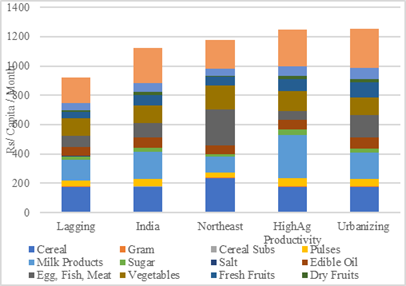 Changing nature of diet. Increase in income, urban growth, processes of globalization and demographic changes have led to a reduction in the relative importance of cereals while consumption of animal-based protein, processed, and purchased food has increased. Hence, we argue that such dietary transitions should move food security debates away from access to calories into access and affordability of diverse and quality diets. Diversification of food supply system should thus become a focus for food and agricultural policy. At the same time, policy should also concern itself with the rising consumption of sugars, packaged/processed food and ‘eating-out’ which often leads to obesity and other non-communicable disease. We argue for bringing urban food security concerns into the larger policy discussion.
Changing nature of diet. Increase in income, urban growth, processes of globalization and demographic changes have led to a reduction in the relative importance of cereals while consumption of animal-based protein, processed, and purchased food has increased. Hence, we argue that such dietary transitions should move food security debates away from access to calories into access and affordability of diverse and quality diets. Diversification of food supply system should thus become a focus for food and agricultural policy. At the same time, policy should also concern itself with the rising consumption of sugars, packaged/processed food and ‘eating-out’ which often leads to obesity and other non-communicable disease. We argue for bringing urban food security concerns into the larger policy discussion.
Chapter 5. The Nutrition Transformation: From Undernutrition to Obesity
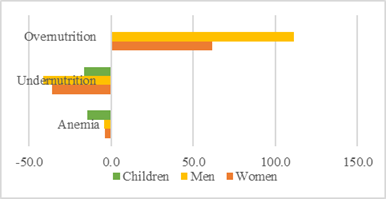 Through this chapter, we provide pathways through which malnutrition can be tackled. We present evidence that across groups, diversifying diets, increasing income and livelihood opportunities is important for reducing malnutrition. Also improving education, increasing empowerment of women and improving access to public infrastructure (water, sanitation, health) all improve malnutrition reduction. Over the last three decades, policy makers have implemented a number of interventions towards malnutrition reduction. Under nourishment has decreased by least ten percentage points. Tackling micronutrient deficiency continues to remain a public health challenge and the number of overweight individuals has increased drastically over the last ten years. In order to broaden the knowledge base available for tackling under nutrition and hidden hunger, we present evidence on successful interventions implemented both regionally and globally. We also bring together literature on the pathways through which obesity (over-nutrition) is impacted and discuss tools and interventions that can be used to reduce its rising incidence.
Through this chapter, we provide pathways through which malnutrition can be tackled. We present evidence that across groups, diversifying diets, increasing income and livelihood opportunities is important for reducing malnutrition. Also improving education, increasing empowerment of women and improving access to public infrastructure (water, sanitation, health) all improve malnutrition reduction. Over the last three decades, policy makers have implemented a number of interventions towards malnutrition reduction. Under nourishment has decreased by least ten percentage points. Tackling micronutrient deficiency continues to remain a public health challenge and the number of overweight individuals has increased drastically over the last ten years. In order to broaden the knowledge base available for tackling under nutrition and hidden hunger, we present evidence on successful interventions implemented both regionally and globally. We also bring together literature on the pathways through which obesity (over-nutrition) is impacted and discuss tools and interventions that can be used to reduce its rising incidence.
Chapter 6. Reimagining Safety Net Programs
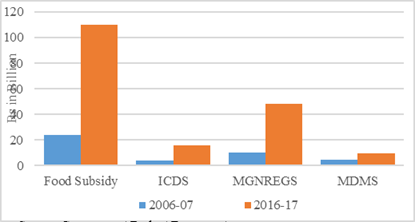 The current sets of safety nets provide income and nutritional assistance during different stages of the life-cycle of an individual. Critics have pointed out to inefficiencies in the design and delivery mechanisms which reduce effectiveness of these programs in benefitting the targeted population. As India urbanizes, focusing on urban poor – an ignored aspect of safety net – would increasingly become important. To diversify food systems and cater to changing food demand, existing interlocked staple grain procurement-storage-distribution system needs to go. We discuss the usefulness of Information & Communication Technologies to curb corruption and leakages from the safety nets while protecting individual privacy. Finally, we highlight the complimentary role of essential public goods provision together with the expansion of safety nets for reducing structural poverty.
The current sets of safety nets provide income and nutritional assistance during different stages of the life-cycle of an individual. Critics have pointed out to inefficiencies in the design and delivery mechanisms which reduce effectiveness of these programs in benefitting the targeted population. As India urbanizes, focusing on urban poor – an ignored aspect of safety net – would increasingly become important. To diversify food systems and cater to changing food demand, existing interlocked staple grain procurement-storage-distribution system needs to go. We discuss the usefulness of Information & Communication Technologies to curb corruption and leakages from the safety nets while protecting individual privacy. Finally, we highlight the complimentary role of essential public goods provision together with the expansion of safety nets for reducing structural poverty.
Chapter 7. Enabling Smallholder Prosperity through Commercialization and Diversification
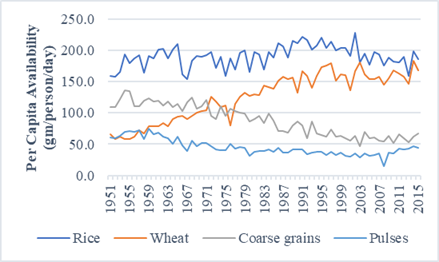 India will be the most populous country in the world by the year 2050. Keeping in mind the need to achieve zero hunger, the two central concerns for food security is how to increase productivity and how to diversify food production. This has brought about opportunities for growth and new challenges to the agricultural sector.The potential for small farms to benefit from these changes depend on their ability to commercialize and diversify. In this chapter, we look at the scope of institutional interventions to rectify small farm disadvantages. We assess the scope of aggregation models such as cooperatives and farmer producer organizations in addressing the scale disadvantages of accessing capital and technology. We touch upon the need to revisit the issue of land reforms and access to mechanization and credit.
India will be the most populous country in the world by the year 2050. Keeping in mind the need to achieve zero hunger, the two central concerns for food security is how to increase productivity and how to diversify food production. This has brought about opportunities for growth and new challenges to the agricultural sector.The potential for small farms to benefit from these changes depend on their ability to commercialize and diversify. In this chapter, we look at the scope of institutional interventions to rectify small farm disadvantages. We assess the scope of aggregation models such as cooperatives and farmer producer organizations in addressing the scale disadvantages of accessing capital and technology. We touch upon the need to revisit the issue of land reforms and access to mechanization and credit.
Chapter 8. Linking Farms to Markets: Reducing Transaction Costs and Enhancing Bargaining Power
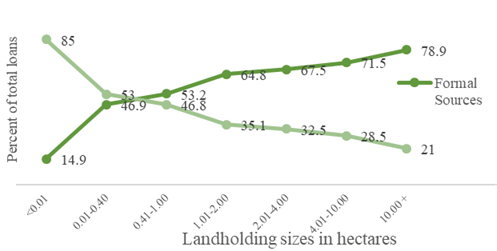 The ability of smallholders to realize remunerative prices for crops grown is determined by their ability to access agricultural markets. Markets are largely unorganized with limited infrastructure and poor systems that cannot cater to quality and specifications demanded by urban consumers. Therefore, parallel to traditional markets, organized value chains relying on more direct linkages with farms and alternative markets based on electronic sales platforms, commodity futures and warehousing systems are needed and fast emerging. In this chapter, we discuss the successes and difficulties of implementing vertical coordination models, increasing access to commodity futures markets and warehousing and encouraging private-public ventures to rectify these efficiency losses. Reducing transaction costs through improved connectivity, development of market infrastructure, limiting the influence of intermediaries will be central to this goal. In addition, we show that aggregation models will rectify scale disadvantages, will enable better participation of smallholders in different marketing arrangements.
The ability of smallholders to realize remunerative prices for crops grown is determined by their ability to access agricultural markets. Markets are largely unorganized with limited infrastructure and poor systems that cannot cater to quality and specifications demanded by urban consumers. Therefore, parallel to traditional markets, organized value chains relying on more direct linkages with farms and alternative markets based on electronic sales platforms, commodity futures and warehousing systems are needed and fast emerging. In this chapter, we discuss the successes and difficulties of implementing vertical coordination models, increasing access to commodity futures markets and warehousing and encouraging private-public ventures to rectify these efficiency losses. Reducing transaction costs through improved connectivity, development of market infrastructure, limiting the influence of intermediaries will be central to this goal. In addition, we show that aggregation models will rectify scale disadvantages, will enable better participation of smallholders in different marketing arrangements.
Chapter 9. Agricultural Technology for Increasing Competitiveness of Small Holders
 Agricultural Technology plays a vital role in building viable and sustainable food systems. The green revolution (GR) is a landmark example of how scale-neutral technology transformed agricultural production leading to increased productivity and availability of staple grains, poverty reduction and lower food prices. The limitations of GR technology were that it was concentrated to few crops and to high potential regions where irrigation was available. In this chapter, we identify that solving the challenge of production in the face of rising population and reducing the impact from climate change requires investments in bio-technology and in developing sustainable agricultural systems.We also discuss the role of first and second generation GM technologies in reducing costs of production, increasing crop resilience to climate change and increasing nutritive value of crops. There is a need for India to have more forward-looking biotechnology policy. This is essential to bolster innovation towards climate change mitigation and adaption.
Agricultural Technology plays a vital role in building viable and sustainable food systems. The green revolution (GR) is a landmark example of how scale-neutral technology transformed agricultural production leading to increased productivity and availability of staple grains, poverty reduction and lower food prices. The limitations of GR technology were that it was concentrated to few crops and to high potential regions where irrigation was available. In this chapter, we identify that solving the challenge of production in the face of rising population and reducing the impact from climate change requires investments in bio-technology and in developing sustainable agricultural systems.We also discuss the role of first and second generation GM technologies in reducing costs of production, increasing crop resilience to climate change and increasing nutritive value of crops. There is a need for India to have more forward-looking biotechnology policy. This is essential to bolster innovation towards climate change mitigation and adaption.
Chapter 10. Managing Climate Change Risks in Food Systems
 In this chapter, using our food systems approach, we provide evidence on the pathways through which climate change will impact food security. Climate change risks must not be understated and actions towards its mitigation and adaptation need to be adopted in regional development policies. Climate change will decrease crop and livestock productivity thus impacting regional crop production and thus food availability. Through direct and indirect channels, climate change will reduce access to nutrition in food, increase susceptibility to communicable and non-communicable diseases. It will negatively impact short term health and labor productivity. This chapter proposes diversification of the food system in ways that simultaneously enhance the environment while improving access to nutrition to ensure nutrition security of all individuals.
In this chapter, using our food systems approach, we provide evidence on the pathways through which climate change will impact food security. Climate change risks must not be understated and actions towards its mitigation and adaptation need to be adopted in regional development policies. Climate change will decrease crop and livestock productivity thus impacting regional crop production and thus food availability. Through direct and indirect channels, climate change will reduce access to nutrition in food, increase susceptibility to communicable and non-communicable diseases. It will negatively impact short term health and labor productivity. This chapter proposes diversification of the food system in ways that simultaneously enhance the environment while improving access to nutrition to ensure nutrition security of all individuals.
Chapter 11. The Way Forward: Food Systems for Enabling Rural Prosperity and Nutrition Security

